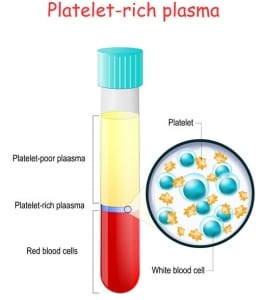Platelet Rich Plasma Therapy (PRP)
Platelet Rich Plasma Therapy is a nonsurgical regenerative medicine treatment that uses your own body’s blood plasma and platelets to accelerate the healing process. If you have sustained a tendon or ligament injury, or suffer from chronic back or neck pain, you may be a good candidate for PRP depending on your unique medical condition.
Platelet-rich plasma is blood plasma with concentrated platelets. These concentrated platelets contain vital growth factors that initiate tissue repair and regeneration. The high concentration of platelets in the plasma solution creates a localized inflammatory reaction that stimulates the growth of new ligament and tendon fibers, cartilage, and bone. The PRP process replicates the body’s natural healing response where blood swells around an injured area of the body to protect it and facilitate healing.
PRP has been very well studied and has excellent safety and therapeutic outcomes.
How does PRP work?
 Treatments are a multistep process that is completed during one office visit. PRP involves:
Treatments are a multistep process that is completed during one office visit. PRP involves:
- Drawing the patient’s blood;
- Placing it in a centrifuge to separate the plasma from the red blood cells;
- Injecting the plasma solution back into the patient’s body at the site(s) of injury/degeneration.
The PRP procedure visit – which includes a blood draw, blood preparation time, and then the injections by the physician – usually takes approximately 45 minutes. Typically, a series of 1-3 treatments are needed, occurring 2-4 weeks apart.
The highly concentrated platelets in the plasma solution release growth factors and cytokines that stimulate the growth and repair of cartilage, tendon, ligament, and bone.
What conditions does PRP treat?
- Back and Neck pain
- Repetitive stress injuries
- Osteoarthritis (i.e. knee, hip, shoulder, spine, etc.)
- Rotator cuff tears
- Sprains
- Tennis elbow
- Golfer’s elbow
- Plantar fasciitis/ACL injuries
- Achilles tendon injuries
- Knee meniscal/cartilage tears
- Labral tears of the hip
- Sciatica (also known as lumbar radiculopathy)
- Bulging disks/tears
- Temporomandibular joint (TMJ) syndrome
- Sexual dysfunction in women*
- Hair loss**
*In addition to orthopedic injuries, PRP can be used to improve painful intercourse (dyspareunia), vaginal dryness, and even enhance orgasm. For more information on the O-Shot®, click here.
**Dr. Lisa Lilienfield is now offering PRP for Hair Restoration. For more information, click here.
Questions? Give Us a Call!
Who should consider PRP?
- Patients with a severe or nagging injury that has not resolved with conventional treatment methods;
- Patients who have tried or are considering cortisone injections and want a more effective, longer-lasting solution;
- Patients who are facing surgery and would like to explore non-surgical treatment methods;
- Patients requiring rehabilitation after an injury or surgery can recover more quickly;
- Patients with high demands (i.e. athletes) who are unaccepting of decline from prior high function or unwilling to accept a future of limitations.
- Women with vaginal dryness, painful intercourse, stress incontinence, and difficulty or inability to achieve an orgasm. For more information on the O-Shot®, which utilizes PRP, click here.
Benefits of PRP “versus” surgery
- PRP helps patients avoid surgery altogether.
- Compared to an operation, PRP carries a substantially lower chance of infection.
- Unlike most surgical procedures, Platelet Rich Plasma treatment does not exclude future surgical options. Technology and surgical techniques are improving rapidly such that a delay in surgical intervention by six months to a year can open up dramatic possibilities for new technological advances, second opinions and time for pre-habilitation.
- PRP is less invasive than any surgical procedure.
- Platelet Rich Plasma has a considerably shorter recovery period than post-surgery.
- PRP leaves no scar tissue or irreversible destruction of skin, muscle, ligaments, tendons or cartilage.
- Surgery requires intravenous antibiotics which disrupt the body’s normal healthy bacteria including the gut microbiome.
- Surgery is a major stressor to the endocrine system including cortisol production which will delay healing.
- Anesthesia can be dangerous. General anesthesia can cause cognitive dysfunction. Regional nerve blocks can cause nerve damage.
- The cost of surgery is significantly higher when calculating “cost” as including lost time from work/activities, risk of complications such as infection and other adverse outcomes, recovery time and out-of-pocket expenses.
If you are interested in scheduling an appointment for PRP, or if you just want to learn more about the procedure as it relates to your medical condition, please call our office to schedule your appointment today. Call 703-532-4892, ext. 2.